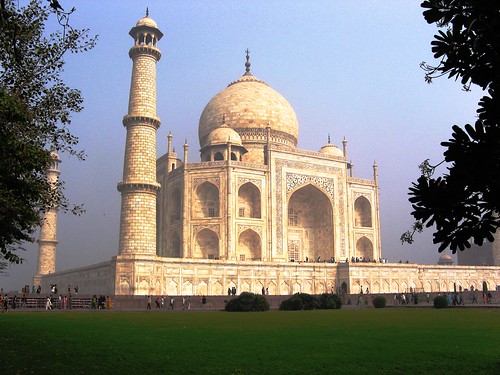For this exercise in tactile, visual and kinesthetic learning, please compete the following -
- All material on one sheet in notebook.
- Cut out image of Taj. Building topped by an onion-shaped dome flanked by smaller, simple domes.
- Glue to notebook page.
- Use pen to draw outline of window and door frames.
- Use pen to add filigree - calligraphy and arabesques - on walls.
- Add the narrow pools that bisect the gardens. Dark green color.
- Add green lawns indicating gardens.
- Built in 1600's.
- Shah Jahan was a notable Muslim emperor and patron of the arts. He imported craftsmen and artists from Persia and other regions. Many of the finest forts, gardens, palaces and mosques in Delhi were built by Shah Jahan.
- Mumtaz Mahal was his wife, confidante and constant companion. Her name means "Jewel of the palace."
- The Taj Mahal is a mausoleum solely dedicated to his wife and her tomb.
- The design is based on Persian and Muslim architecture.
- The minarets remind the viewer that the Islamic call to prayer, 5 times a day, is chanted by muezzins in the towers.
- Arabic script is well suited to calligraphic presentation.
- Vine-like and geometric designs called Arabesques also decorate the walls.
- There is a mosque on one side and a matching guest house on the other side of the Taj.
- Symmetry was a guiding principle.
- Map of India: include Delhi and Agra.
- Snappy title.
- A massive Gate House provides a formal entrance to the gardens and the Taj.
- Anomaly: the Taj is an anomaly in that it is the most famous building in India but does not reflect Hindu design or faith. Actually, the Muslim population of India was once larger than today's approximately 14%.
- Aurangzeb: as an aging emperor, Shah Jahan was imprisoned by his son Aurangzeb, who succeeded him and reportedly disapproved of his father's profligacy. Discarding the relative tolerance of his forebears, Aurangzeb brought a Taliban-style rule, trying to impose a literal Islam and persecuting and penalizing Hindus and others.

